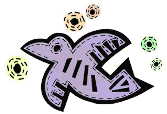|
Start Page |

Dynamic Aspects Workshop (DAW04)
March 23rd, 2004, Lancaster, United Kingdom
(held in conjunction with AOSD 2004)
Important Dates
- January 19th, 2004, Deadline for Submissions
- February 9th, 2004, Notification of Acceptance
- February 13th, 2004 AOSD Early Registration Deadline
- March 22nd-26th, 2004, AOSD in Lancaster
- March 23rd, DAW04
Latest News
2004-03-12 DAW'04 proceedings are available for download
2004-03-02 the lists of accepted papers and posters is available
2004-01-09 the web pages have been moved to the AOSD server
2003-11-05 first version of the web page is online
What is this workshop about?
Join points are the locus of aspect and functional code interaction. Traditional aspect systems define join points in terms of the static structure of programs. Method wrappers, before and after method calls, variable setting and retrieving, and structural identification of object fields are all examples of traditional join points.
Beginning with the "Jumping Aspects" paper of Brichau et al., examples began to emerge in which it was desirable to invoke or change aspect behavior based on the dynamics of program execution. Such situations include changing behavior based on the call-stack context, co-occurrence of predicate triggers, concurrent thread status, or events in the underlying interpreter such as storage reclamation or process scheduling. Cflow in AspectJ was one response to the need for dynamic aspects.
This workshop will seek to identify examples of useful dynamic aspect behavior, suggest appropriate linguistic structures for dynamic aspects, and discuss implementation techniques for dynamic aspects, such as shadow compilation and modifications required in the underlying execution environment. The workshop organizers are particularly interested in position papers that describe experience with dynamic aspect systems or that outline real problems which need dynamic aspects.
The topics of the workshop include:
- Applications of dynamic aspects,
- Models for dynamic aspects,
- Techniques for validating dynamic aspect programs,
- Linguistic structures for dynamic aspects,
- Dynamic action expression and linguistic integration,
- Implementation mechanisms for dynamic aspects,
- Enabling technologies and environment support for dynamic aspects (e.g., debuggers, IDEs),
- The relationship between dynamic aspects and the rest of a software system,
- Challenges and research directions.
Copyright Notice
The jackdaw image is © Penny Ellis, www.tumbletales.com.
2004-03-02 Michael Haupt, <haupt@informatik.tu-darmstadt.de> |